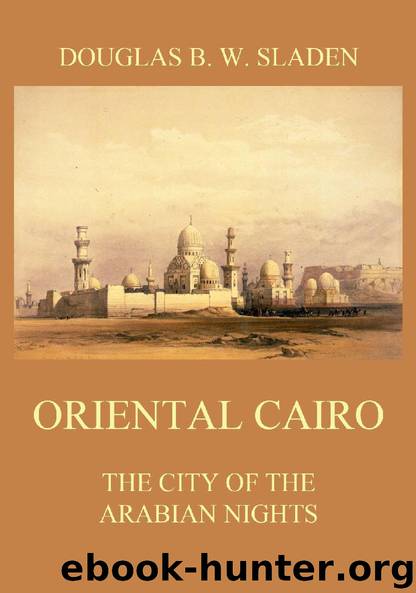Oriental Cairo - The City of the Arabian Nights by Douglas Brooke Wheelton Sladen

Author:Douglas Brooke Wheelton Sladen [Sladen, Douglas Brooke Wheelton]
Language: eng
Format: epub
Tags: Travelogues
Publisher: Jazzybee Verlag
Published: 2019-05-19T22:00:00+00:00
CHAPTER XVII. Old Cairo and the Wonderful Coptic Churches of Babylon
OLD Cairo is not a mere term of effect. It is not a summarisation of mediaeval remains—it is the name of the quarter of the city built on the fringe of the Roman fortress and the original capital of the Caliphs. This original capital was not called Cairo—Amr-ibn-el-Asi, the victorious general of the Caliph Omar, who conquered Egypt in A.D. 638 called it Fustat, perhaps from the leather tent which he used while he was besieging the Roman fortress, though etymologists believe that the name is the Byzantine corruption of the Roman fossatum—an entrenched camp.
Old Cairo itself is of no great interest except as a rather unspoiled patch of native life with quaint little mosques. But it is surrounded with bonnes bouches for the kodaker and the antiquarian.
It stands right on the Nile. Men, women, and children, primitive enough in their simplicity for the wilds of Upper Egypt, swarm down its steep bank into the battered gyassa which is to take them across the swift current to the village of Gizeh, which gives its name and nothing more to the Pyramids.
Right under the bank is the island of Roda, where, according to tradition (and to be near enough to Cairo), Moses was found in the bulrushes. Across the Nile is the long line of the Pyramids from Medum to Abû Roasch, the famous Field of the Pyramids.
Right above the streets of Old Cairo rises the Egyptian Babylon, the fortress of the Romans besieged and taken by Amr, and monopolised, since its ruin, by the Copts. And beyond that are the vast mounds which contain in their bosoms all that was left of Fustat, when it had been burnt in 1168 to prevent it falling into the hands of the Crusaders.
It is of Fustat and Babylon that I must write, for neither receives its meed at the hands of the tourist.
Fustat began to lose its importance when the Caliph Ibn Tulun built his mosque, which still survives, and his palace in the quarter now called Katai. A new city sprang up round them; Fustat grew still further neglected.
When Gohar el-Kaid conquered Egypt for the Fatimite Caliphs, and founded the new palace known as El-Kahira, or the Splendid, in 969, it lay between the Citadel and the Governorat, and the bazars and the native streets surrounding them stand upon its site. The noble old loggia of the Beit-el-Kadi just above the Sûk of the Coppersmiths is part of the Palace of El-Kahira, though built long after the days of Gohar.
When the Crusaders were sweeping down on Cairo, since the Saracenic forces were not sufficient to hold so large an area, Fustat was committed to the flames. The fire burnt steadily for fifty-four days. Those who have seen, even the day after, the débris of a great fire, can understand how the dust-storms and the intermittent rain of seven or eight centuries have turned the smouldering ruins of the city of Amr into the fortress-like mounds of the Fustat of to-day.
Download
This site does not store any files on its server. We only index and link to content provided by other sites. Please contact the content providers to delete copyright contents if any and email us, we'll remove relevant links or contents immediately.
| Africa | Americas |
| Arctic & Antarctica | Asia |
| Australia & Oceania | Europe |
| Middle East | Russia |
| United States | World |
| Ancient Civilizations | Military |
| Historical Study & Educational Resources |
Black Genesis by Robert Bauval(1589)
Serpent in Sky by John Anthony West(1030)
The Egyptian Book of the Dead by John Romer(813)
The White Nile by Alan Moorehead(754)
100 Hieroglyphs by Barry Kemp(620)
The Emerald Tablets of Thoth the Atlantean by M. Doreal(595)
Nasser by Saïd K. Aburish(564)
Think Like an Egyptian by Barry Kemp(549)
Legends Of The Gods (Illustrated And Annotated Edition) by E. A. Wallis Budge(538)
Lost Technologies of Ancient Egypt: Advanced Engineering in the Temples of the Pharaohs by Dunn Christopher(529)
Egypt - Culture Smart! The Essential Guide to Customs & Culture by Jailan Zayan(513)
Osiris and the Egyptian Resurrection, Vol. 1: 001 by Budge E. A. Wallis(508)
Egyptian Magic (Illustrated And Annotated Edition) by E. A. Wallis Budge(504)
The Ultimate Ambition in the Arts of Erudition by Shihab al-Din al-Nuwayri(492)
The Ultimate Ambition in the Arts of Erudition by al-Nuwayri Shihab al-Din(486)
Egyptian Myths And Mysteries by Steiner Rudolf(475)
Ancient Egyptian Warfare by Ian Shaw(470)
A History of the Middle East: Fourth Edition by Peter Mansfield & Nicolas Pelham(465)
Ramesses by Joyce Tyldesley(450)
